

 |
||
 |
||
Vol. 11 (1): June 2008 |
||
Croatia / Greece I / Greece II / Madeira / Mauritania & Western Sahara / Turkey
Turkey
|
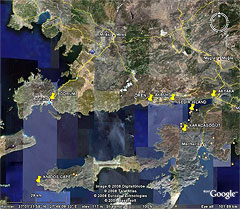 |
|
|
Enlarge map. |
Following her rehabilitation, she was successfully released back to nature in Gökova Bay on 28 April 2007. Thirteen months later, Badem remained in the same general area, freely wandering the whole bay, and covering long distances. After November 2007, she started to frequent the coastline from Karacasöğüt up to Bodrum, mostly spending time in the inner part of Gökova Bay. The Ministry of Environment, Mugla Governorship, Datça sub-Governorship, Turkish Coast Guard boats, fish farm operators, private and touring yacht owners, local people and press were duly presented with information, advising people not to approach Badem to help her to readapt more quickly to her life in the wild. An illustrated colour leaflet in Turkish and English was also designed and printed by SAD-AFAG including ‘Dos & Donts’ and basic information about monk seals; these were widely distributed in the area. Most local people, fishermen, yacht captains and conservationists approached the problem in a very constructive manner, while Turkish Coast Guard boat commanders proved always conscientious and knowledgeable, and remained in close contact with SAD-AFAG via a 24-hour GSM hotline in case a new observation or development warranted immediate action or advice.
For several weeks since 2 February 2008, Badem began wandering around the Karaca fish farm in Karacasöğüt. The operator, who is already an AFBIKA member of SAD-AFAG, contacted us as an additional precautionary step. He was afraid that Badem might cause damage to his fish cages. An outer protection net encompassing the whole farm was proposed as a solution by us, as this method has been tried many times elsewhere in Turkey with full success.
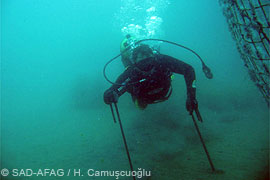 |
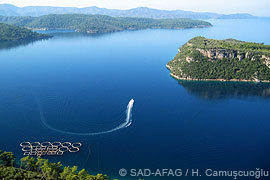 |
|
|
|
|
The owner agreed to lay the outer net, and did so with his own efforts. However, because of openings left at the bottom, Badem was able to break through the outer net and swim around the nursery cages. The owner, meanwhile, had become rather attached to the young seal, and would not bring himself to harm it.
In order to resolve the situation, however, SAD-AFAG urgently deemed it necessary to provide additional materials (anchors, J-iron bars, and additional outer protection net), labour (including divers), and diving/filming/photography equipment to the fish farm, and allocated funds obtained from an additional sponsorship by Mustafa Koç for this action. After modification and reinforcement jobs had been completed by our divers on 28 March 2008, Badem could no longer enter through the outer protection net. In conclusion, the fish farm sustained no damage in their cages and no financial loss, while 2 or 3 other fish farms in the vicinity were reportedly not visited by Badem.
Badem has, of course, received some attention from tourists and local people during the most recent period, despite public information through the press, newspapers, TV and radio channels. On 10 May 2008, for example, 5 local people and a German tourist wanted to take Badem to the beach in Akyaka after they swam together with Badem in shallow water. And finally Badem, as an instinct to defend herself, bit all of them, inflicting upon two serious injuries.
This event has been covered in the press very extensively, most voicing the opinion – without SAD-AFAG intervention – that Badem had been right to sink her teeth into such arrogant guys, and people should take it as a warning not to interact with her.
The incident served as a reminder to tourists and local people that Badem is a wild, not a domestic, animal. At the same time, Badem has helped to create along Turkish coast a significant public awareness boost for endangered marine mammal species, and monk seals.
No other public awareness or environmental education activity could disseminate such information in such a short period of time. However, although we are quite satisfied with this unexpected development, our primary aim was not to create a PA campaign in Turkey, but rather for Badem to readapt to her natural way of life as soon as possible. Zafer Kızılkaya of SAD-AFAG visited Badem in the 3rd and 4th week of May 2008 to check on the situation in Gökova Bay, and reminded local people and tourists on their conduct when in the vicinity of the seal – reminders he also delivered through the media. – Cem O. Kıraç and Harun Güçlüsoy / SAD-AFAG.
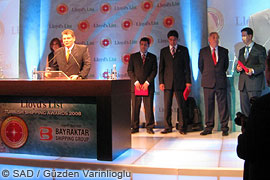 |
|
|
Recipients receive their awards for the rescue, rehabilitation and release of “Badem” from Christopher Meyer, Executive Editor in Lloyd’s List. |
On 15 May 2008, London-based Lloyd’s List, the prominent press and publication organization for the world’s maritime and shipping industry, held a ceremony to announce the 2nd Turkish Shipping Awards at Kempinsky Çırağan Palace in Istanbul. With more than 500 guests from Turkey and abroad in attendance, including Hasan Naiboglu, Undersecretary of Maritime Affairs, Dr. Özkan Poyraz, Director General for Maritime Transport and Metin Kalkavan, President of Turkish Shipping Chamber, the Turkish Shipping Awards were presented in their various categories. As a special category, SAD-AFAG, together with Foça Municipality, SRRC (Seal Rehabilitation and Research Centre Lenie ’t Hart) and Mr. Mustafa Koç, were presented plaques for the rescue, rehabilitation and successful release of young monk seal “Badem” in April 2007. Cem Orkun Kıraç, Harun Güçlüsoy, Yalçın Savaş, Haluk Camuşcuoglu and Guzden Varinlioglu represented SAD-AFAG in the ceremony, while Mayor Gokhan Demirag and Dr. Avni Gök represented Foca Municipality; Yagiz Eyuboglu Koç and his family were also in attendance. – Münevver Çakır, SAD-AFAG.
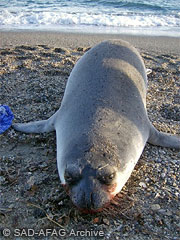 |
|
|
Death at Bozyazı. |
|
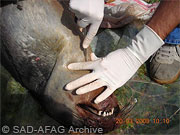 |
|
|
The necropsy, performed |
The commander of the Coast Guard boat in Bozyazı, Mersin, in southern Turkey reported the discovery of a dead monk seal to SAD-AFAG’s headquarters on 11 March 2008 as part of AFBIKA – AFAG’s Monk Seal Information & Rescue Network. The alert was swiftly transferred to Mehmet Sarı, SAD-AFAG’s Aydincik Representative, who immediately visited the site and reported the incident to the Ministry of Environment and Forest, National Parks and Wildlife General Directorate. Officers dispatched to the scene found the body of a dead juvenile female seal.
From first impressions, the cause of death could not be determined. The body was not in a state of decomposition, nor were there any apparent signs of injury or trauma to her body, though her mouth bore signs of copious bleeding. Following an official request, authorized officers from the Ministry of Environment and Forest granted authority to Mehmet Sarı for a necropsy and further investigation to be conducted. The seal’s body was preserved in a deep-freeze until veterinary surgeon Dr. Avni Gök could travel to the region to conduct the necropsy on behalf of SAD-AFAG.
When Gök arrived at Aydıncık on 19 March 2008, his first action was to take an x-ray, which indicated trauma, with signs of cerebral haemorrhage. Following detailed internal and external examination the following day, the cause of death – which had been the cause of much speculation among fishermen and NGOs in Bozyazı – was confirmed: according to the official necropsy report of the veterinary surgeon, the young female seal died due to cerebral haemorrhage and a trauma, caused by a violent blow to the front of the head. – Cem O. Kıraç and Harun Güçlüsoy / SAD-AFAG.
Concerned that the degrees of protection afforded to some SIT protected areas in the Çeşme and Alaçatı regions of Izmir, western Turkey, were being decreased, SAD-AFAG applied to the Supreme Court (Danıştay) to halt the decision of the Council of Ministers for development plan changes followed by decreased SIT degrees from 1st to 2nd and even from 1st to 3rd – against the interests of coastal habitats [see NGOs unite against downgrading of protected areas, TMG 9(1): June 2006]
In May 2008, our lawyers were notified that the joint consortium including SAD, Doğa Derneği, Ege Doğa Derneği and Greenpeace had won the court case against the Tourism & Cultural Assets Protection Council (TCAPC) in Izmir, thereby halting the decision of the Council of Ministers for development plan changes in the Alaçatı and Çeşme areas. Prior to the decision of the Council of Ministers, TCAPC had downgraded the SIT status of some coastal areas in Alaçatı & Çeşme regions. The above-mentioned NGO consortium had also applied to the District Administrative Court (Bölge İdare Mahkemesi) to reverse these decisions. Though our joint application was partially accepted by the court, downgrading decisions affecting other SIT areas remained in place. The consortium will now appeal that decision in the Higher Supreme Court (Temyiz).
The untouched coasts having 1st and 2nd degree SIT protection status under question are very important for the continued survival of monk seals as well as other elements of coastal and marine ecosystems in the Çeşme Peninsula and Alaçatı-Sığacık regions, since construction and restoration of existing buildings are impossible or very limited, keeping the coastal habitat virtually undisturbed.
Should these milestone decisions be finally established by the Supreme Court and the District Administrative Court in Turkey, the pristine coastal habitats near Çeşme and Alaçatı would be protected for many long years. SAD-AFAG places habitat protection as a priority in the conservation of endangered species and ecosystems. – Cem O. Kıraç / SAD-AFAG.
On 24 October 2007, a panel known as Local Problems and National Solutions, operating under a general framework for Integrated Coastal Zone Management (ICZM), was organized in Foça. The panel represented the final activity of an EC-funded SMAP project entitled ‘Promoting Awareness and Enabling a Policy Framework for Environment and Development Integration in the Mediterranean with Focus on Integrated Coastal Zone Management’, carried out by the UNEP-MAP PAP/RAC and the Underwater Research Society in Turkey. The main aim of the project was to increase public awareness of the ICZM and establish a specific day for celebrations and PA activities in all Mediterranean countries on 24 October. One of the important outcomes of the panel project was the declaration of the necessity of a Management Plan for the Foça Special Environmental Protection Area. Immediately after this declaration, SAD-AFAG wrote an official letter to the Environmental Protection Agency for Special Areas (EPASA) (formerly the Authority for the Specially Protected Areas), as a reminder that it is the responsibility of the Agency to prepare the management plan for Foça, and that SAD-AFAG stands ready to provide and help with its own data and logistics for such a plan.
This letter was well received by the Agency and, as a first step, the President of EPASA Mr. Önder Kıraç, publicly revealed the roadmap and draft planning procedure for the Foça SPA that would form the basis for further consultation at the Foça and Turkish Maritime Symposium, held on 9-11 January 2008. The Symposium, in which SAD-AFAG played a key role, attracted wide participation.
Further developing the process, on 1 February 2008, the Agency invited SAD-AFAG to Ankara in order to brief Agency technicians and directors on the data and information that SAD-AFAG have compiled on the Foça Special Environmental Protection Area. Following the meeting, the Agency announced two tenders to determine the present socio-economic status and the carrying capacity of the area in terms of maritime traffic and the marine environment. Currently, the first study is in progress, while the other is still in the tendering process. It is predicted that the plan will be ready by the end of 2009. – Harun Güçlüsoy, SAD-AFAG.
SAD-AFAG and CSIC are jointly carrying out surveys of the Turkish coast as part of a Mediterranean-wide project that aims at diagnosing the health of the underwater ecosystem. The surveys focus on five areas (Ayvalik, Gokova, Fethiye, Kas and Aydincik) along the Aegean and Mediterranean coasts of Turkey, to take place between 3 - 24 May 2008. The main concept of the study is to develop a cost-effective method to evaluate the ecosystem status of any given site. The results of the surveys can be used to determine conservation priorities (e.g. where to create a marine reserve), to support adaptive management to fulfil reserve goals and, most important, to accelerate the recovery and ensure the conservation of coastal ecosystems. The project’s main focus of interest in the Eastern Mediterranean is to survey coastal ecosystems that harbour Mediterranean monk seals. The results will allow us to determine the ecological scale of habitat use by monk seals. A similar study will be conducted in Greece in June 2008, in collaboration with MOm. – Zafer Kızılkaya / SAD-AFAG and Enric Sala / CSIC.
Three new pups have been recorded along Turkey’s SW coasts, from Fethiye, Kaş and Kemer respectively, on the Teke Peninsula. Locals from the Ölüdeniz region near Fethiye called AFAG’s GSM line on 28 November 2007, reporting a monk seal pup on a beach. The photos later sent via email clearly show that the pup is around 2-3 months old and healthy.
SAD-AFAG did not take any action to move the pup from the area and waited for the animal to leave the beach of its accord and move away from human activities later that same day. Our contact person and local fishermen scanned the vicinity on 28 and 29 November but did not encounter the pup.
News of a second pup reached SAD-AFAG member Atila Kara and SAD-AFAG Kaş representative K. Gökhan Türe from a pebble beach near the town of Kaş on 6 December 2007. The pup was observed trying to hide under a bush near the shoreline. Again, the animal was monitored by SAD-AFAG members; it appeared healthy and was no doubt born during the 2007 pupping season.
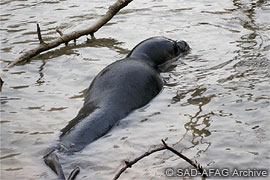 |
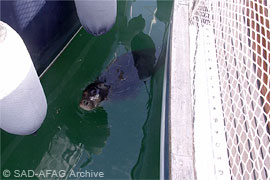 |
|
|
Monk seal pup in Ölüdeniz near Fethiye. |
Monk seal pup in Kemer Marina in Kemer town near Antalya. |
The pup later returned to the sea of its own accord, swimming away from the coast. Monitoring by SAD-AFAG members and fishermen on that and subsequent days failed to encounter the pup again.
Finally, news of a third pup was received from Kemer Marina officials on 12 December 2007. Information from both telephone calls and emails with photos, indicated that a pup about 3 months old was wandering inside the port and swimming among the boats without any fear. Kemer Marina officials requested instructions on how to protect the young monk seal, though all indications were that the pup was healthy. During a continuous contact with SAD-AFAG, marina officials were strongly advised not to intervene, but only to monitor the juvenile seal in case any assistance might be needed. It left the marina area the same day after spending some time among the boats. Despite careful monitoring with the help of local people, no sighting of the animal was made during subsequent days.
Combined, the three sightings raise hopes for the continued survival of the species along the SW coasts of Turkey, where SAD-AFAG and IFAW conducted joint habitat surveys in the summer of 2007. – Cem O. Kıraç / SAD-AFAG.
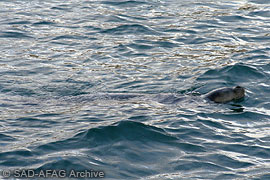 |
|
|
Sighting along north coasts of Marmara. |
An adult female monk seal was observed on 8 and 10 December 2007 by a local on the north coasts of the Marmara Sea, near Istanbul. This represents an exceedingly rare sighting, since the species is thought to exist only in very small numbers in the Marmara. Detailed information and photos were obtained from the observer, and the sighting data duly entered into SAD-AFAG’s FokData database. – Cem O. Kıraç and Harun Güçlüsoy, SAD-AFAG.
In February 2008, a documentary film on orphaned monk seal Badem was completed, following the course of her rehabilitation and release back to the wild. Produced by SAD-AFAG, the film, in Turkish, was directed by Yurdakul Kabasakal.
Besides featuring the course of the rehabilitation, the film also covers SAD-AFAG conservation activities in Foça and other coastal locations since 1993. Ninety minutes in length, the documentary was prepared with the financial support of the Foça Municipality. DVD copies of the documentary are available at SAD-AFAG headquarters in Ankara and at the organisation’s Foça office. – Cem O. Kıraç / SAD-AFAG.
SAD-AFAG participated in environmental education programmes at the Bilkent university and schools of Ankara from February to April 2008. SAD-AFAG’s Cem Orkun Kıraç made presentations covering various issues, including the importance of wild habitats for endangered species, such as monk seal, sea and shore birds. – Münevver Çakır / SAD-AFAG.
AFAG celebrated its 20th anniversary in Ankara on 16 December 2007, with the participation of SAD and METU Subaqua Society members, on the occasion of the 7th General Assembly of SAD. Founding principles, main activities and achievements were shared with the support of archive photos, while future targets were explained and discussed among the members and supporters. Founded in September 1987, AFAG ultimately aims and struggles for the protection of both monk seals and their wild habitats along Turkish coasts. – Münevver Çakır / SAD-AFAG.
WWF-Turkey presented SAD-AFAG with the 2008 Panda Award for its long term conservation efforts for the survival of the monk seal in Turkey, in a ceremony held on 24 May in Bodrum. The awards ceremony was held during the WWF Annual Congress, whose theme this year is Global Climate Change. The Congress is also the venue for the presentation of WWF-Turkey’s first-ever Panda Awards. Also receiving the same award was Esra and Aylin Koç, the daughters of Turkish businessman Mustafa Koç who sponsored the rehabilitation of Badem. WWF-Turkey declared that both Esra and Aylin had made a positive difference in the perceptions of the public at large in the conservation of the critically endangered monk seals. – Harun Güçlüsoy / SAD-AFAG.
Ambassador with Attitude
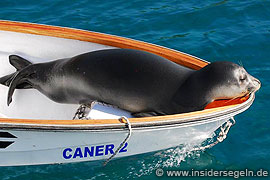 |
|
|
Badem ahoy! (Courtesy www.insidersegeln.de) |
Since her release in April 2007, Badem, the orphaned monk seal pup, has become something of an ambassador for her species. But while endearing herself to the Turkish public with her antics, attracting tourists, and spawning pages of press coverage, this ambassador-with-attitude also bites, posing a risk not only to those who may deserve it most, but also innocent swimmers who venture too close. Potential risks to Badem herself have also been voiced.
Rescued in December 2006, Badem underwent rehabilitation in Foça with both Turkish and Dutch expertise, but became imprinted on her human carers during the 5-month process.
We present below a selection of recent press and media coverage of Turkey’s famous seal.
Badem, the Mediterranean monk seal
We have been extremely fortunate at our resort with regular visits from a very friendly and famous Mediterranean Monk Seal (Monachus monachus) called Badem (translates to Almond). […]
There are a few basic rules with Badem in the water however, to ensure that she does return to life in the wild successfully:
Please do not get close to her and try and stand at least 10 meters away when she is sleeping on the beach, do not speak loudly and do not touch her. If she does play with you underwater or on the surface, please do not be afraid of her but try not to show an interest in her if possible and most important rule of all DO NOT give her any kind of food.
We generally found that she has a routine when she comes into Defneli, arriving between 9-10 in the morning (just as the beginners and snorkellers are getting ready to go in the water) and has a couple of hours swimming around with people from the beach, after lunch when she has been playing all morning she will come up onto the beach for her afternoon nap on one of the sunbeds or will even try and get into one of the kayaks!
– Badem, the Mediterranean monk seal. European SeaSports, Marmaris, Turkey, date accessed, 25 February 2008.
Didim seal becomes a tourist attraction!
A RESCUED seal from Didim is becoming an instant hit with tourists on the high seas as it follows their tourist voyager boats.
The baby seal, nicknamed Badem, was found wounded on Didim Mavişehir shore last year and treated in İzmir before being released in the sea at Gökova by the Minister of Forestry.
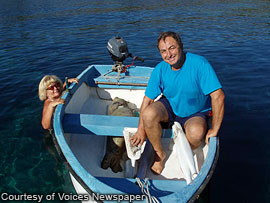 |
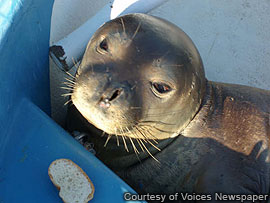 |
|
|
|
|
It spent most of the winter on the open seas around the Bodrum Akyaka region and people from across the area have been flocking to the shore to see the seal.
Captain Osman Demirci, who runs blue voyage tours in Didim and Bodrum, said the arrival of Badem had seen his tours increase – even if they are out of season.
He said: “Especially on Saturdays and Sundays, many people from Muğla and its districts come to see Badem. Badem is very accustomed to people and does not leave here. It is like the mascot of the area.” Osman said that Badem had come on their boat during a blue voyage.
He said: “The tourists on the boat could not believe their eyes and some were scared. Badem was following the boat. I was curious as to what it would do so I stopped the boat. It looked around for a few minutes and then came on the boat. It was our guest for six hours. All our customers had an unforgettable day.”
Didim seal becomes a tourist attraction! The Voices Newspaper, 2 March 2008.
The Seal in Love
[…] Obviously she finds a dinghy again, and hey presto she’s in it. Most of the owners are not delighted at all, as Badem smells somewhat sharp. With all kinds of tricks they try to keep Badem out of the dinghies. A protective tarpaulin over the dinghy, rocking the dinghy, if need be join forces to throw her out and lay her on the jetty, what doesn’t all occur to people? Mostly in vain, however, because Badem is so in love with small boats, that sooner or later she finds another one and cheekily looks out of it. If nothing at all helps anymore, she lies on the rusty fish cages of the restaurant and sleeps there for a spell.
Naturally it would be nice if she could join other monk seals. The specialists, which have raised her, ask in their information sheet not to pay any attention to Badem when she wants to play, not to touch and in no case to feed her. The latter is easy, she does not give a hungry impression. But the former is easier said than done. Such a trusting seal is undoubtedly THE attraction wherever she appears. […]
Die verliebte Robbe, Der Insider, Autumn 2007.
Does seal Badem need people?
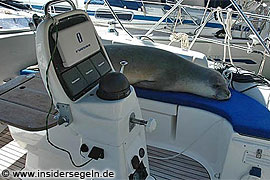 |
|
|
|
[…] Although the animal protectionists call for caution and consider too much attention too dangerous for the health of the animal, it seems precisely the opposite: Badem is seeking contact, climbs on fishing boats and dinghies, doesn’t shy away from crawling up swaying gangways up onboard sailing yachts and there, pleasurably lies down for hours of sleep on the upholstery of the cockpit bench. During daytime she easily manages to sleep for 10 to 12 hours. At night she crawls away, disappears in the sea and goes fishing.
Wherever she appears she becomes the attraction. The people come running, surround her, take out photo and film cameras, and even try to pet her or swim with her. Not always does this end without injuries: in […] a girl was bruised and had to have her leg treated. But Badem is not at all malicious, just sometimes a little bit too wild when splashing around and diving.
Admittedly, no one knows quite what is going on in the head of the seal. Does she search for people because she was raised by them? Are they even something like ‘substitute parents’? Or does she act like an actor used to applause, who, once enjoying the affection, can no longer be without it? It’d certainly be good if experts could take care of the psyche of Badem, to prevent her being harmed by too much (or too little) human contact. […]
Braucht Robbe Badem die Menschen? Der Insider, April 2008.
Further information
Monk seal pup ‘Badem’ returns home. The Monachus Guardian 10 (1): June 2007.
Orphan’s behaviour provoking concerns in Turkey. The Monachus Guardian 10 (1): June 2007.
Orphaned pup’s welfare monitored daily, The Monachus Guardian 10 (2): November 2007.
SAD-AFAG Badem information brochure, 2007. [PDF ![]() 286KB]
286KB]
For Badem’s Journal, a blog of the rehabilitation crew (English and Turkish), photos and video, visit www.sadafag.org/yavrufok_eng.htm
AFAG Video of Badem and her rehabilitation can be found on youtube.com at:
http://www.youtube.com/watch?v=XMOSb3-tGgI
http://www.youtube.com/watch?v=MolDeS241jg
Divers and the Mediterranean Monk Seal, by European Seasports Turkey:
http://www.youtube.com/watch?v=ig9JfIOA9PE&feature=related
Pay to prey
“However many types of hunting a hunter knows, a bear knows just as many escape routes.” - Turkish proverb
FETHIYE, Turkey - The Turkish Ministry of the Environment and Central Hunting Commission recently announce its 2007-08 hunting fines. Editors are never happy to miss an arresting headline, so Hurriyet newspaper jazzed up the news with a picture of a large brown bear sitting with its paw raised toward the article titled “Permission to kill - 18,000 liras” (US$14,000).
The fines depend on the rarity of the animals. Killing an Anatolian leopard nets the highest fine on the list at 35,000 liras ($27,000), but that sum is largely irrelevant, as most wildlife organizations suspect that the breed is already extinct because of trophy hunting in the 1980s and 1990s. Second in the pantheon come fallow deer, red deer, wild sheep (Anatolian and other), and Asian brown bears, which will each set you back 18,000 liras. Brown-bear populations in Turkey have not been subject to detailed surveys, but it is known that outside of four core areas in the east of the country, their numbers have been declining rapidly as forests decrease in size, human populations increase, and expanded road networks allow man to invade what was previously secluded bear habitat.
Next on the list are spotted hyenas at 12,000 liras and the Mediterranean monk seal at 8,000 liras [€ 4,200 approx.]. Considering there are only about 400 monk seals in the Mediterranean and only about 50 in Turkey, and that the animal is listed as “critically endangered” by the World Conservation Union (WCU), this price seems a little low. The list of other mammals includes ibex and chamois at 7,000 liras, roe deer, gazelles and lynx at 5,000 liras, water sables, wild cats and caracals at 4,000 liras, and finally the bargain basement of the mammalian world, wolves and spotted martens at only 850 liras. […]
– Fazile Zahir, Pay to prey, Asia Times, 15 August 2007.
EndQuoteSo why do they call it the Black Sea? No one really knows the answer - but theories abound. Locals I talked to say it got the name because of the countless boats that have gone out and never returned, leaving generations of women mourning for their lost husbands. Recent catastrophic events support the theory that the name reflects an association with mortality. In the last few weeks terrible storms have claimed up to 20 lives and wrecked four ships, including a Russian-registered oil tanker that left a black slick lapping the shoreline. Yet such calamities are not exclusive to this sea. Though ignorant of these scientific facts, the ancient Persians were wary of these stormy waters, referring with trepidation to what they called the “dark sea.” So were the ancient Greeks, who called it the “Inhospitable Sea,” purportedly because the fierce Thracian tribes living along the coast would attack their ships. But the Greeks were flexible people; they changed their view once they had colonized much of the coast, and began calling it the “Hospitable Sea.” The name didn’t stick. It wasn’t until the 13th century that the Turks started calling it the Black Sea. During this period, the descendants of Genghis Khan and his Mongol empire were pushing westward into Europe. […] Today, the coast here is lively as can be. Everywhere you turn there is ground being broken and another crane pulling in. Vacation resorts are sprouting up as foreign investors discover the beauty of the beaches and the value of the waterfront. Soon the coast will be lined with balconies providing wonderful views of the crystal blue waters that cover the dark, lifeless depths and their wrecked ships.
|
Copyright © 2008 The Monachus Guardian. All Rights Reserved |